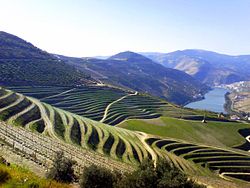
In viticulture, the climates of wine regions are categorised based on the overall characteristics of the area's climate during the growing season.[1] While variations in macroclimate are acknowledged, the climates of most wine regions are categorised (somewhat loosely based on the Köppen climate classification) as being part of a Mediterranean (for example Tuscany[2][nb 1]), maritime (ex: Bordeaux[3]) or continental climate (ex: Columbia Valley[4]). The majority of the world's premium wine production takes place in one of these three climate categories in locations between the 30th parallel and 50th parallel in both the northern and southern hemisphere.[5] While viticulture does exist in some tropical climates, most notably Brazil, the amount of quality wine production in those areas is so small that the climate effect has not been as extensively studied as other categories.[6]
- ^ Cite error: The named reference
Fraga2016was invoked but never defined (see the help page). - ^ S. Siddons "How the Tuscany Wine Region Works" TLC Cooking, Accessed: 18 January 2010
- ^ M. Ewing-Mulligan "France's Bordeaux Wine Region" Dummies.com Reference page. Accessed: 18 January 2010
- ^ A. Mumma "The Washington wine difference: it's in the vineyard" Wines & Vines, November 2005
- ^ T. Stevenson "The Sotheby's Wine Encyclopedia" pg 14-15 Dorling Kindersley 2005 ISBN 0-7566-1324-8
- ^ J. Robinson (ed) "The Oxford Companion to Wine" Third Edition pg 179-195, 388, 428-434, 716-714 Oxford University Press 2006 ISBN 0-19-860990-6
Cite error: There are <ref group=nb> tags on this page, but the references will not show without a {{reflist|group=nb}} template (see the help page).
© MMXXIII Rich X Search. We shall prevail. All rights reserved. Rich X Search
